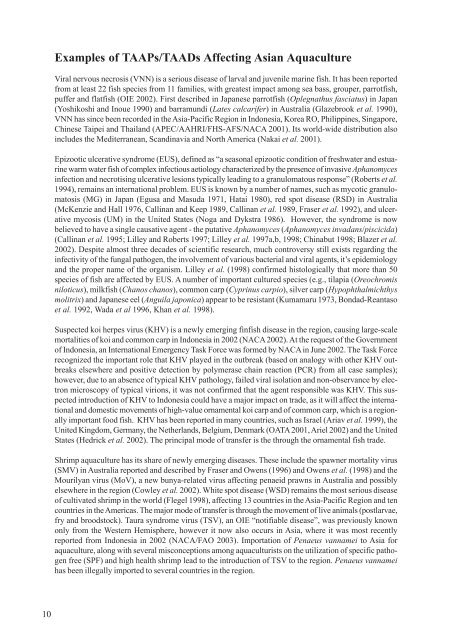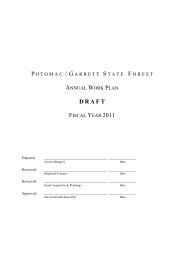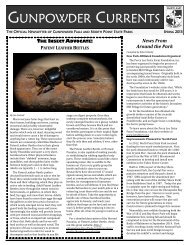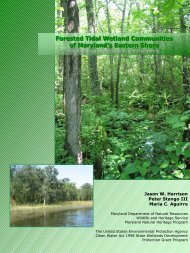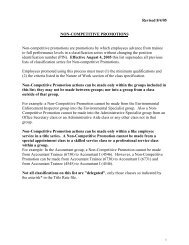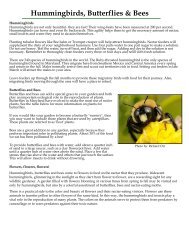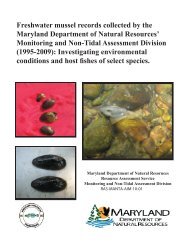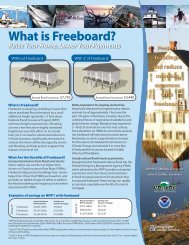NAca Section 2.pmd - Maryland Department of Natural Resources
NAca Section 2.pmd - Maryland Department of Natural Resources
NAca Section 2.pmd - Maryland Department of Natural Resources
Create successful ePaper yourself
Turn your PDF publications into a flip-book with our unique Google optimized e-Paper software.
10<br />
Examples <strong>of</strong> TAAPs/TAADs Affecting Asian Aquaculture<br />
Viral nervous necrosis (VNN) is a serious disease <strong>of</strong> larval and juvenile marine fish. It has been reported<br />
from at least 22 fish species from 11 families, with greatest impact among sea bass, grouper, parrotfish,<br />
puffer and flatfish (OIE 2002). First described in Japanese parrotfish (Oplegnathus fasciatus) in Japan<br />
(Yoshikoshi and Inoue 1990) and barramundi (Lates calcarifer) in Australia (Glazebrook et al. 1990),<br />
VNN has since been recorded in the Asia-Pacific Region in Indonesia, Korea RO, Philippines, Singapore,<br />
Chinese Taipei and Thailand (APEC/AAHRI/FHS-AFS/NACA 2001). Its world-wide distribution also<br />
includes the Mediterranean, Scandinavia and North America (Nakai et al. 2001).<br />
Epizootic ulcerative syndrome (EUS), defined as “a seasonal epizootic condition <strong>of</strong> freshwater and estuarine<br />
warm water fish <strong>of</strong> complex infectious aetiology characterized by the presence <strong>of</strong> invasive Aphanomyces<br />
infection and necrotising ulcerative lesions typically leading to a granulomatous response” (Roberts et al.<br />
1994), remains an international problem. EUS is known by a number <strong>of</strong> names, such as mycotic granulomatosis<br />
(MG) in Japan (Egusa and Masuda 1971, Hatai 1980), red spot disease (RSD) in Australia<br />
(McKenzie and Hall 1976, Callinan and Keep 1989, Callinan et al. 1989, Fraser et al. 1992), and ulcerative<br />
mycosis (UM) in the United States (Noga and Dykstra 1986). However, the syndrome is now<br />
believed to have a single causative agent - the putative Aphanomyces (Aphanomyces invadans/piscicida)<br />
(Callinan et al. 1995; Lilley and Roberts 1997; Lilley et al. 1997a,b, 1998; Chinabut 1998; Blazer et al.<br />
2002). Despite almost three decades <strong>of</strong> scientific research, much controversy still exists regarding the<br />
infectivity <strong>of</strong> the fungal pathogen, the involvement <strong>of</strong> various bacterial and viral agents, it’s epidemiology<br />
and the proper name <strong>of</strong> the organism. Lilley et al. (1998) confirmed histologically that more than 50<br />
species <strong>of</strong> fish are affected by EUS. A number <strong>of</strong> important cultured species (e.g., tilapia (Oreochromis<br />
niloticus), milkfish (Chanos chanos), common carp (Cyprinus carpio), silver carp (Hypophthalmichthys<br />
molitrix) and Japanese eel (Anguila japonica) appear to be resistant (Kumamaru 1973, Bondad-Reantaso<br />
et al. 1992, Wada et al 1996, Khan et al. 1998).<br />
Suspected koi herpes virus (KHV) is a newly emerging finfish disease in the region, causing large-scale<br />
mortalities <strong>of</strong> koi and common carp in Indonesia in 2002 (NACA 2002). At the request <strong>of</strong> the Government<br />
<strong>of</strong> Indonesia, an International Emergency Task Force was formed by NACA in June 2002. The Task Force<br />
recognized the important role that KHV played in the outbreak (based on analogy with other KHV outbreaks<br />
elsewhere and positive detection by polymerase chain reaction (PCR) from all case samples);<br />
however, due to an absence <strong>of</strong> typical KHV pathology, failed viral isolation and non-observance by electron<br />
microscopy <strong>of</strong> typical virions, it was not confirmed that the agent responsible was KHV. This suspected<br />
introduction <strong>of</strong> KHV to Indonesia could have a major impact on trade, as it will affect the international<br />
and domestic movements <strong>of</strong> high-value ornamental koi carp and <strong>of</strong> common carp, which is a regionally<br />
important food fish. KHV has been reported in many countries, such as Israel (Ariav et al. 1999), the<br />
United Kingdom, Germany, the Netherlands, Belgium, Denmark (OATA 2001, Ariel 2002) and the United<br />
States (Hedrick et al. 2002). The principal mode <strong>of</strong> transfer is the through the ornamental fish trade.<br />
Shrimp aquaculture has its share <strong>of</strong> newly emerging diseases. These include the spawner mortality virus<br />
(SMV) in Australia reported and described by Fraser and Owens (1996) and Owens et al. (1998) and the<br />
Mourilyan virus (MoV), a new bunya-related virus affecting penaeid prawns in Australia and possibly<br />
elsewhere in the region (Cowley et al. 2002). White spot disease (WSD) remains the most serious disease<br />
<strong>of</strong> cultivated shrimp in the world (Flegel 1998), affecting 13 countries in the Asia-Pacific Region and ten<br />
countries in the Americas. The major mode <strong>of</strong> transfer is through the movement <strong>of</strong> live animals (postlarvae,<br />
fry and broodstock). Taura syndrome virus (TSV), an OIE “notifiable disease”, was previously known<br />
only from the Western Hemisphere, however it now also occurs in Asia, where it was most recently<br />
reported from Indonesia in 2002 (NACA/FAO 2003). Importation <strong>of</strong> Penaeus vannamei to Asia for<br />
aquaculture, along with several misconceptions among aquaculturists on the utilization <strong>of</strong> specific pathogen<br />
free (SPF) and high health shrimp lead to the introduction <strong>of</strong> TSV to the region. Penaeus vannamei<br />
has been illegally imported to several countries in the region.


